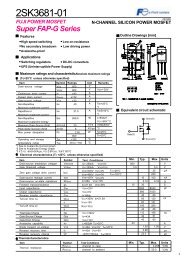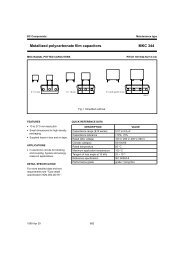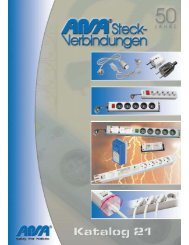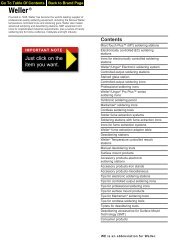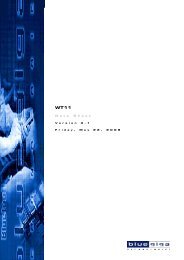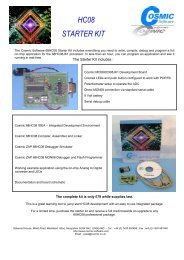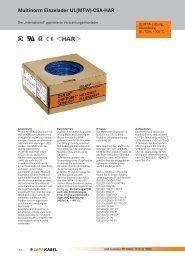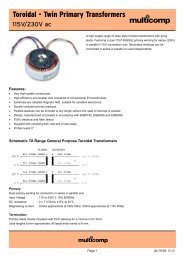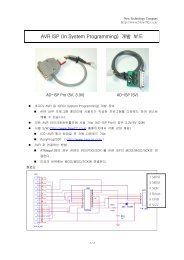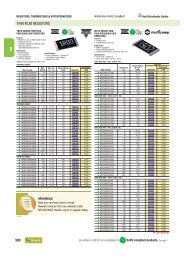Safety Data Sheet Ronson Butane Refill Mar02
Safety Data Sheet Ronson Butane Refill Mar02
Safety Data Sheet Ronson Butane Refill Mar02
You also want an ePaper? Increase the reach of your titles
YUMPU automatically turns print PDFs into web optimized ePapers that Google loves.
SAFETY DATA SHEET<br />
RONSON BUTANE REFILL<br />
SDS Reference No. : 02/115<br />
Issue Date : March 2002<br />
Revision No. : 0<br />
I. PRODUCT AND COMPANY IDENTIFICATION<br />
1.1 Identification of the substance or preparation:<br />
RONSON BUTANE REFILLS (90ml to 400ml)<br />
1.2 Company Identification: <strong>Ronson</strong> International Ltd.<br />
Station Works<br />
Long Buckby<br />
Northampton NN6 7PF<br />
1.3 Emergency Telephone: 01327 841 500 (office hours only)<br />
II. COMPOSITION/INFORMATION ON INGREDIENTS<br />
2.1 Chemical composition : blend of hydrocarbons consisting primarily of<br />
propane, iso-butane and n-butane<br />
Component CAS No % Composition<br />
Propane 000074-98-6 22<br />
n-butane 00106-97-8 54<br />
iso-butane 000075-28-5 24<br />
2.2 Risk phrases : Extremely flammable gas<br />
2.3 Classification/symbol : Extremely flammable gas/F+<br />
III. HAZARDS IDENTIFICATION<br />
Extremely flammable liquefied gas.<br />
Eyes: contact with liquid or gas under pressure can cause frostbite<br />
(cold burns)<br />
Skin: contact with liquid can cause frostbite (cold burns)<br />
Inhalation: may cause irritation to nose and throat, headache, nausea,<br />
vomiting, dizziness, euphoria, drowsiness. In poorly ventilated<br />
or confined areas, unconsciousness and asphyxiation may<br />
result.<br />
SDS 02/115 PAGE I MARCH 2002
IV. FIRST AID MEASURES<br />
SAFETY DATA SHEET<br />
RONSON BUTANE REFILL<br />
4.1 Eye contact : Flush immediately with plenty of water for at least 15<br />
minutes.<br />
Hold eyelids apart while flushing to rinse entire<br />
surfaces of eyes and lids with water. Get immediate<br />
medical attention.<br />
4.2 Skin contact : In case of cold burns, immediately place affected area<br />
in tepid to warm water, and keep immersed until<br />
circulation returns.<br />
4.3 Inhalation : Remove patient immediately to uncontaminated area.<br />
Keep warm and at rest. If breathing has stopped or<br />
shows signs of failing, commence artificial respiration.<br />
Get immediate medical attention.<br />
4.4 Ingestion : No emergency care anticipated, since product is a gas<br />
under normal conditions.<br />
4.5 Immediate medical advice : Severe inhalation/over exposure may sensitize<br />
the heart to catecholamine-induced arrhythmias. Do<br />
NOT administer catecholamines to an over-exposed<br />
person.<br />
V. FIRE FIGHTING MEASURES<br />
5.1 Special fire/explosion hazard : can form explosives mixtures with air.<br />
Containers exposed to fire can explode<br />
and catch fire.<br />
5.2 Products of combustion : oxides of carbon<br />
5.3 Fire fighting procedures/ : dry powder only.<br />
extinguishing media<br />
VI. ACCIDENTAL RELEASE MEASURES<br />
6.1 Personal protection : Avoid contact with liquid and vapour.<br />
6.2 Environmental precautions : extinguish all naked flames and sources of<br />
ignition; disperse vapour.<br />
6.3 Method of cleaning up : disperse vapour with water spray.<br />
SDS 02/115 PAGE II MARCH 2002
VII. HANDLING AND STORAGE<br />
SAFETY DATA SHEET<br />
RONSON BUTANE REFILL<br />
7.1 Precautions during handling : do not use in the vicinity of naked flames and<br />
sources of heat.<br />
7.2 Precautions during storage : store in a suitable approved location away<br />
from sources of heat and ignition.<br />
7.3 Packing materials : aerosol containers.<br />
VIII. EXPOSURE CONTROLS/PERSONAL PROTECTION<br />
8.1 Special protective measures : use in well ventilated areas.<br />
Respiratory : avoid exposure to vapour.<br />
Hand : avoid contact<br />
Eye : avoid contact<br />
Skin : avoid contact<br />
8.2 Exposure limits : long term (8hr TWA) : 600 ppm<br />
: short term (10 mins) : 750 ppm<br />
IX. PHYSICAL AND CHEMICAL PROPERTIES<br />
9.1 Physical state : colourless liquefied gas<br />
9.2 Odour : odourless<br />
9.3 Temperature characteristics : boiling point : -11 o C<br />
9.4 pH : not applicable<br />
9.5 Solubility – in water : insoluble<br />
9.6 Vapour pressure (25 o C) : 3.18 – 3.46 bar (3.24 – 3.53 kg/cm²)<br />
9.7 Specific Gravity of liquid (25 o C) : 0.552<br />
Specific Gravity of vapour (15 o C) : 1.91 (air = 1)<br />
9.8 Flammability<br />
- flash point : -74 to -104 o C<br />
- auto ignition temperature : 405 - 550 o C<br />
- flammable limits : 1.8 – 10.0% in air<br />
X. STABILITY AND REACTIVITY<br />
10.1 Stability : can form explosive mixtures with air.<br />
10.2 Conditions/materials to avoid : strong oxidizing agents, peroxide,<br />
plastics, chlorine dioxide, and<br />
concentrated nitric acid.<br />
10.3 Hazardous decomposition products : normally carbon dioxide (carbon<br />
monoxide if deficiency in oxygen<br />
supply)<br />
SDS 02/115 PAGE III MARCH 2002
SAFETY DATA SHEET<br />
RONSON BUTANE REFILL<br />
XI. TOXICOLOGICAL INFORMATION<br />
11.1 Toxicological data<br />
11.2 Effects of exposure<br />
- eyes : not applicable, product is a gas.<br />
- skin : not applicable, product is a gas.<br />
- inhalation : not determined.<br />
- ingestion : not applicable, product is a gas.<br />
- carcinogenicity : no known behaviour.<br />
- mutagenicity : no known behaviour.<br />
- tetratogenicity : no known behaviour.<br />
XII. BIOLOGICAL INFORMATION<br />
12.1 Mobility : evaporates into atmosphere<br />
12.2 Persistence and degradability : degrades under atmospheric conditions.<br />
Hydrocarbons have zero ozone depletion<br />
potential.<br />
12.3 Ecotoxicity : no known ecological damage caused by this<br />
product.<br />
XIII. DISPOSAL CONSIDERATIONS<br />
13.1 Disposal of product : do not discharge into areas where there is a<br />
risk of forming an explosive mixture.<br />
13.2 Disposal of packaging : as with other aerosol packaging.<br />
XIV. TRANSPORT INFORMATION<br />
14.1 UN No. : 1950 (Aerosols)<br />
14.2 UK road<br />
- Hazchem Code : 2WE<br />
- Classification : flammable gas<br />
14.3 RID-ADR : Class 2, Liquefied Gas (2,3b)<br />
14.4 IATA/ICAO : Flammable Gas<br />
SDS 02/115 PAGE IV MARCH 2002
SAFETY DATA SHEET<br />
RONSON BUTANE REFILL<br />
XV. REGULATORY INFORMATION<br />
15.1 Chemicals (Hazard Information and Packaging) Regulations 1994:<br />
- Risk phrases : R13 Extremely flammable liquefied gas<br />
- <strong>Safety</strong> Phrases : S16 Keep away from sources of ignition –<br />
no smoking<br />
S9 Keep in a well ventilated place<br />
- Classification/symbol : Extremely flammable/F+<br />
15.2 Exposure limits : long term (8hr TWA) : 600 ppm<br />
: short term (10 mins) : 750 ppm<br />
15.3 National legislation : The Chemicals (Hazard Information &<br />
Packing) Regulations 1994.<br />
The Control of Substances Hazardous to Health<br />
Regulations.<br />
The Health and <strong>Safety</strong> at Work Act.<br />
XVI. OTHER INFORMATION<br />
16.1 Recommended uses : refills for cigarette lighters<br />
16.2 Sources of data used to : suppliers’ data sheets<br />
compile data sheet<br />
16.3 Sections revised : none<br />
This information is given in good faith and is based on information and tests believed<br />
to be reliable. The suitability of this product for any particular use is not suggested or<br />
implied. This document is not a specification and properties shown are not<br />
guaranteed.<br />
SDS 02/115 PAGE V MARCH 2002



